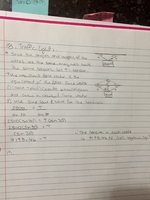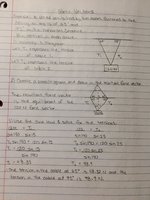Question:

Hello!
I am just looking for clarity on whether I have answered this question correctly.
I do not feel like the answer I got, by following an example in the lesson for this practice question, is correct. From my understanding, if the weight is pulling downwards, the tension is less than the weight. I googled whether the tension on the wires by a hanging object could be greater, and the answer I got was no.

Excuse the messy writing, I am typing the question after completing it and wasn't too concerned about my hand writing.
The following is the text before step 3)'s work.
"- since the angles and lengths of the wires are the same, they will have the same tensions. Let T = tension.
2) - the resultant force vector is the equilibrate of the 2500 force vector.
- Create a parallelogram and draw in the resultant force vector.
3) Use sine law and solve for the tension."
This is the example question I followed. It does have two different angles. I figured it would be the same process just without having to solve for separate tensions since the tensions in my question should be the same.

I would love some clarity! And if the answer is correct, but something in the question is wrong it would not be the first time!
Thank you so much!
Cheers,
Alli
Hello!
I am just looking for clarity on whether I have answered this question correctly.
I do not feel like the answer I got, by following an example in the lesson for this practice question, is correct. From my understanding, if the weight is pulling downwards, the tension is less than the weight. I googled whether the tension on the wires by a hanging object could be greater, and the answer I got was no.

Excuse the messy writing, I am typing the question after completing it and wasn't too concerned about my hand writing.
The following is the text before step 3)'s work.
"- since the angles and lengths of the wires are the same, they will have the same tensions. Let T = tension.
2) - the resultant force vector is the equilibrate of the 2500 force vector.
- Create a parallelogram and draw in the resultant force vector.
3) Use sine law and solve for the tension."
This is the example question I followed. It does have two different angles. I figured it would be the same process just without having to solve for separate tensions since the tensions in my question should be the same.

I would love some clarity! And if the answer is correct, but something in the question is wrong it would not be the first time!
Thank you so much!
Cheers,
Alli

